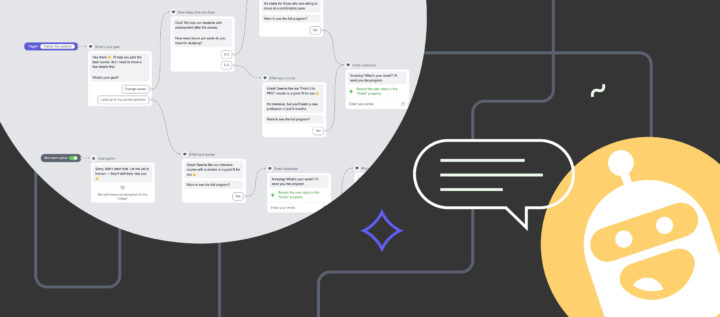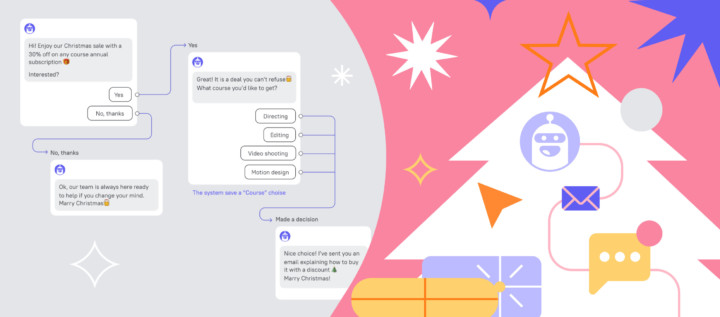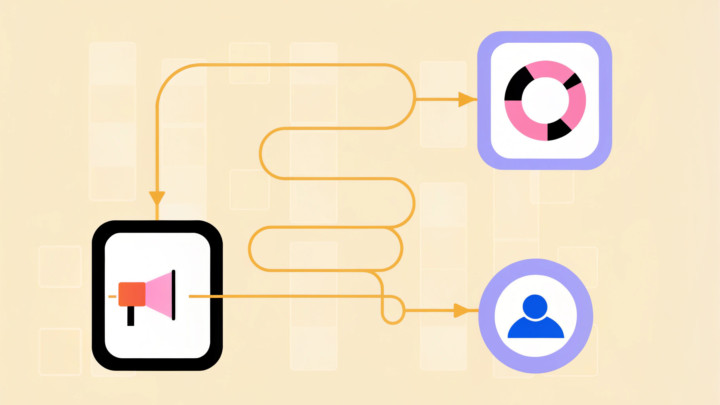What is lead nurturing

In this article, we’ll share our learnings about how to guide a customer to purchase if you have a complex product; they’re based on experience, mistakes, and testing.
This article is also available in the video format:
Why a business needs to nurture their leads?
Businesses with long transaction cycles:
- expensive product (real estate, cars, complex technology products);
- IT products (platforms);
- new to market and unknown products.
Remember: you need lead nurturing if your product is complex and costly, and it takes long for a customer to make a purchase decision.
Let’s take B2B SaaS companies as an example. Before paying for the subscription plan, a customer wants to fully realize the platform efficiency; they need to see if they can seamlessly integrate the platform into their workflow and align their buying decision with the management. And there are lots of other steps to take before the purchase decision can be made.
Research conducted by the MarketingSherpa Institute shows that 79% of all leads never convert into successful transactions. This is yet another proof that it’s essential to help your customer make a decision in favor of your product through nurturing.
Let us give you an example of possible doubts that a potential customer of some online platform might have. A user wants to find the platform providing the website live chat opportunity:
1.Lots of platform options with much information on them; no time for research.
Ways to eliminate: run paid search ads on queries about competitors and communicate your value in the adverts.
2. Lots of tools in these platforms.
Ways to eliminate: show your customer use cases when they can make use of particular features.
3. Platform marketers praise their products on websites, but I want to read some reviews from people who used it.
Ways to eliminate: ask for user’s email and send them vital information and success stories.
4. Will I master the platform? I’m afraid I’m going to spend a lot of time on it.
Ways to eliminate: guide a user to the video tutorial and send them an onboarding campaign. Sell them an idea that all their effort will pay off excellently.
5. A user chose some expensive platform and they have to look for something else.
Ways to eliminate: give your user demo access and offer them a free trial, bonuses, and special terms.
All of the above actions to eliminate customer doubts are what’s called nurturing; it’s a series of stimulating actions you employ to guide your lead on their way to purchase, and they get hotter as they proceed. This process can automate a part of what your sales force does, and besides, it can perform even better.
Lead nurturing will help you to
- increase sales without acquiring more traffic;
- increase the conversion rate at particular stages where a user interacts with your product;
- keep the customer journey under control and guide them to key actions.
According to the DemandGen report, nurtured leads purchase 20% more compared to non-nurtured ones. That’s why lead nurturing is definitely worth it, you see?
This is some stats by the Dashly editors showing the conversion rate to the signup of two segments, nurtured and non-nurtured ones.
The conversion rate reached 8% thanks to lead nurturing
What makes a good nurturing campaign?
Nurturing itself
It includes standard marketing activities: sending emails with useful content, converting users to follow the blog, creating video tutorials. But you must understand that users need to receive various offers depending on the funnel stage they are at. This is proven by the Pardot State of Demand Generation research: 76% of customers want different content at different stages of getting to know a product.
Segmentation
Segmentation helps you offer relevant content to your users. It works just like that: you divide them into groups by their interests and needs and arrange your content based on that combination.
Scoring
This means evaluating potential customers based on their interactions with your content; it allows dividing segments into subsegments and later guiding them smoothly through the sales funnel. Users get scores as they get nurtured, and when they reach a certain number of scores, it means they are ready to buy. Here’s our article where we elaborated on this in detail.
How to design this campaign:
- Compile the Customer Journey Map and define stages of decision making that a user gets through before buying.
- Develop a nurturing campaign using the content you’re going to offer to your potential customers at each stage that will guide them to the purchase.
- Assign scores to users upon completion of each stage of nurturing. When a user achieves a certain number of scores, rest assured that they’re ready to buy.
Read also:
👉 Live Chat Best Practices: 20 Hacks to Make Customer Service Better
👉7 Best Live Chat for eCommerce: Boost Conversion on your Website
👉 Top 5 live chat mobile app: find the best fit for your business
👉 Live Chat: How Online Chat Tool Can Help Your Business
👉 20 Best Live Chat Software for your website chat service
👉 Acquisition funnel marketing: Grow customer conversions at each step of user journey
👉 The top 15 inbound marketing tools: harness digital power and elevate your business
👉 10 best website personalization tools to deliver top-notch visitors experience
👉 7 best email capture tools: features and pricing compared for 2024
How to design the Customer Journey Map
This is a must before nurturing as it helps you understand your customer and build a sequence of actions for them.
Gather data on your audience
- explore the research you have on your hands about the audience;
- take a poll to obtain the latest data on your customers. We’ve collected the “must-ask” questions to examine the customer journey.
- gather data from your website and social media pages;
- talk to your colleagues that interact with customers;
- talk to customers themselves.
Create buyer personas
A buyer persona is a collective image of your customer segment. These people have something in common. You need several of buyer personas as each has their own path to purchase.
Use the following principles to analyze your customers and create buyer personas:
- age
- gender
- occupation
- place of residence
- lifestyle
- behavioral patterns
- objectives and values
- devices used
- influencers
- issues that a character hires your product to resolve.
Describe the customer journey
There are 4 stages of it:
- Revelation — your customer has a problem and they start looking for solutions; that’s where they find your product. You need to define here what problem a customer might have and what doubts stop them from making a decision.
- Purchasing decision — a customer finds out about your product and starts considering whether it will resolve their problem or not.
- Purchase — a customer buys your product, and you need to understand what influenced their decision. Make use of the Jobs To Be Done theory. It covers user behavior and helps you get insights into why customers opt for your product. Follow this link to learn more.
- Repeat purchases — check what happens with your customer after buying your product.
Analyze the CJM and eliminate bottlenecks
Take a look at your Customer Journey Map and define bottlenecks: at what stages most customers leave, what they find difficult, what they doubt about, and what disappoints them. After that, make sure to draw up a plan to eliminate your weak spots.
Apart from detecting your vulnerabilities, you’ll get some insights which you probably didn’t expect but you’ll definitely make use of them. They will help you arrange nurturing content. Believe us, we know what we’re talking about as we’re testing every point on ourselves. Here’s a fragment of our customer’s journey map:
After we’ve analyzed our customers, we realized that the communication about the product and how it works was not enough. Turns out, there are people who only sign up to see if Dashly is a good fit, and it doesn’t mean they are ready to use the platform. Our major revelation was that we and our customers had different visions of the platform.
Dashly has launched the email course which we marketed through our channels. 3% of the audience signed up on the platform. When we studied the customer journey map, we found out that we were sharing the value but didn’t tell anything about the platform. We’ve developed a small landing page about Dashly that we started to show our customers after they subscribed to the course. The conversion rate to signup to the platform has boosted up to 30%!
“I’ve got the feeling that I actually understand people I’m talking to in different communication channels. That’s crucially important”.
Polly, marketer at Dashly
What to do with the segments, after all?
You’ll define the nurturing strategy as soon as you design the CJM: you need to provide users with the info they need at each stage of decision making.
Let’s look at what nurturing activities different lead types need depending on the stage:
1. Very cold — they don’t know anything about you and cannot articulate their problem. They’ve just left you and your competitors their contact info to see what you can offer.
Your task here is to build product loyalty and help them state their problem.
Solution — tell about yourself and show that you’re an expert to build trust. Convert users to reading your blog: share your thought leadership and success stories.
? Here’s what campaign we run for new Dashly users: we show a pop-up offering to download useful content and just ask for an email in return. When a lead gets into our base, we send them such an email:
2. Warm leads — they’ve shown their interest and want to learn more, but they are still not ready to buy. These users visit your website for who knows what time exactly, they visit various sections and spend some time there.
Your task here is to strengthen their loyalty and offer a solution to the problem.
Solution — show them video tutorials and reviews as they will help deal with user doubts.
One of our clients gives an animated pop-up tour around the platform to such leads to help users become familiar with the functions and make a decision.
3. Hot leads are ready to buy. They’ve been reading your emails and website content for a long time now. They might have used their trial period and now it’s high time to convert them to a paid subscription.
Your task here is not to miss a chance.
Solution — show benefits: bonuses, gifts, special terms, and perks for those who register.
One of our customers is sending this email to leads to encourage them to pay.
If you don’t believe in the power of research, we’ve prepared a useful article on how to arrange product research based on the experience of our fellows at Miro, SkyEng, and Er-Telecom
How nurturing works for us
Here’s how we employ nurturing for ourselves: this is a fragment of the triggered nurturing email campaign for new leads.
A lead that gets to our base receives a welcome email. We start the communication with talking about our newsletter and why they should stay with us.
If a user doesn’t sign up after that, we’ll send them an email in 1 day with the platform tools and a selection of success stories.
If a user is still idle, we wait for 2 more days and then send them an email with useful articles and convert them into reading our blog.
4 days after this email, an idle user will receive a new email with the selection of Dashly tools. In the same email, we offer them to run campaigns for free. Our intention is to convert them to using the trial period and give welcome presents.
If this email doesn’t manage to convert a user, we stop the welcome campaign and start sending them mass emails. This way, we’re building user loyalty, showing our utility, and trying to alleviate their doubts.
Here’s how we can match user doubts to our reaction on them:
You can go through all questions and concerns of your potential customer and work out all objections within the nurturing campaign.
We’ve also described in detail what nurturing email campaigns there are. Pick the one that fits your business and bring it to life!
Read also:
- 3-step guide on inbound lead qualification: how to qualify inbound leads on autopilot
- Choose your ideal lead nurturing platform: Top 10 software tested by experts
- How to implement user tracking on website: guide, tactics, and tools
- Top 10 user activity monitoring tools: tracking features, price, cons and pros
- Top 12 lead qualification tools to deliver your sales hot leads only
- Top 10 customer segmentation tools to personalize customer communications
- 12 best AI marketing tools to automate everything [expert edition]
- Top 12 omnichannel marketing tools for your cross-channel campaigns







